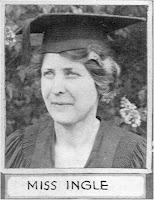 |
| Robert Ingle: 6 Rossmore Rd |
All the earlier rented houses (at least those we know of) are still standing, but 6 Rossmore Road is not. It was demolished in the 1960s to allow for the expansion of Vermont Park. Happily, we have a detailed painting by Robert Ingle of the front of the house, as well as photos of the interior taken in the 1950s and early 1960s.
Bertha sketched the living room and dining room in pencil. Although she didn't do a painting showing the house, there is one picture of an urban streetscape (an unusual subject for her). It has recently occurred to me that it may be a view of neighbouring houses, as seen from her front lawn or thereabouts. I hope to explore further; if I'm right, the houses it shows are still standing, at Rossmore Road and Olive Avenue.
 |
| Interior of 6 Rossmore Rd |
 Home ownership must have brought increased expenses, and that may have been one reason that Bertha undertook what would be her longest continuous teaching assignment. In 1922, she became the Art Teacher at the Ontario Ladies' College (OLC) in Whitby, Ontario, a position she held until 1927.
Home ownership must have brought increased expenses, and that may have been one reason that Bertha undertook what would be her longest continuous teaching assignment. In 1922, she became the Art Teacher at the Ontario Ladies' College (OLC) in Whitby, Ontario, a position she held until 1927. |
| Ontario Ladies' College c. 1920 |
Bertha seems to have been quite happy at OLC. The December 1922 Vox Collegii newsletter describes her active engagement with the students and with College life.
 |
| Front hallway of OLC |
We have a pencil sketch of the front hallway of the College building which she drew for publication in the Yearbook.
 |
| Hama Kobayashi |
An especially sad episode during her years at OLC was the death in 1925 of a student, Hama Kobayashi, who came from a prominent Tokyo family. Bertha had made a portrait of her in pastels, dressed in traditional costume, and we are fortunate to have it still.
Among Bertha's collection of paintings are two by prominent artists she knew from her association with OLC. One is a landscape in oils by Thomas Garland Greene, who was Art Director of OLC during her years there. The other is by Florence Helena McGillivray, a native of Whitby who was Assistant Art Teacher at OLC in the early 1900s. It was probably Ms McGillivray's leave-of-absence in 1908 - 1909 that led to Bertha's first connection with OLC, an assignment as Assistant Art Teacher for that academic year.
And we have an oil painting by Bertha herself that long languished in a dusty frame and under dingy glass. It had a small, heavily tarnished brass plaque on the frame saying:
A gift by the artist
Bertha M. Ingle
A former teacher of the College
As shown here, I have recently removed the glass and had the old gold-coloured paper mat replaced with a more suitable linen-covered liner. I have cleaned the frame and polished the brass plaque. Being framed under glass at least protected the painting from decades of dust and dirt. It looks much happier now.
But there's a puzzle. We're not sure why we have possession of it, if it was originally given to the College. Perhaps it was returned to the family, after Bertha's death. Perhaps it was returned when OLC became Trafalgar Castle School in 1979; a case of out with the old, in with the new. We plan to investigate further. We'll be delighted if the present School administration wishes to hang it there, again, in a place it could be seen and enjoyed as a small part of their history.




























